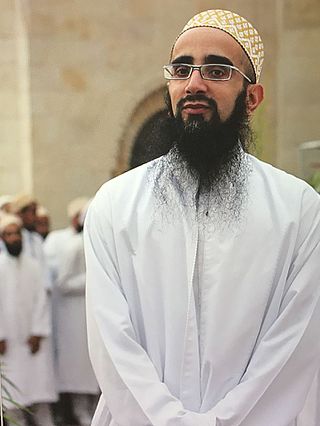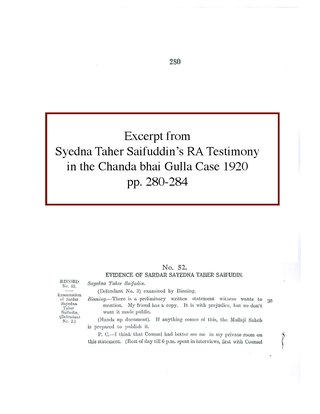Related Research Articles

The Dawoodi Bohras are a religious denomination within the Ismā'īlī branch of Shia Islam. Their largest numbers reside in India, Pakistan, Yemen, East Africa, and the Middle East, with a growing presence across Europe, North America, South East Asia, and Australia. Most estimates put the worldwide population to be one million.

Mohammed Burhanuddin was the 52nd Dā'ī al-Mutlaq of Dawoodi Bohras. He led the community for 49 years in a period of social, economic, and educational prosperity; strengthened and re-institutionalized the fundamental core of the community's faith; revived its culture, tradition, and heritage. In successfully achieving coexistence of traditional Islamic values and modern Western practices within the community, Burhanuddin completed the work his predecessor Taher Saifuddin had started. Burhanuddin was presented the highest national civilian honors of the states of Egypt and Jordan recognising his revivalism and restoration efforts. He was known in Arab countries as Azamat us-Sultan. Owing to extensive travels for community reach-out, he was the first Dā'ī al-Mutlaq to visit Europe, Australia, and America.

The Musta‘lī are a branch of Isma'ilism named for their acceptance of al-Musta'li as the legitimate nineteenth Fatimid caliph and legitimate successor to his father, al-Mustansir Billah. In contrast, the Nizari—the other living branch of Ismailism, presently led by Aga Khan IV—believe the nineteenth caliph was al-Musta'li's elder brother, Nizar. Isma'ilism is a branch of Shia Islam.

Taher Saifuddin, also known as Tahir Sayf al-Din, was the 51st and longest serving Da'i al-Mutlaq of the Dawoodi Bohras. Saifuddin adapted the modernisation in Western and European ideas, and established its benefits for the Bohras, whilst still steeped in the traditions and the culture of the community's Fatimid heritage. Saifuddin laid substantial groundwork in terms of philanthropy, education, entrepreneurship, social outreach, political outreach, and community upliftment upon which his successors, Mohammed Burhanuddin and Mufaddal Saifuddin, continued to build, resulting in unprecedented era of prosperity among the Dawoodi Bohras.

Hatim ibn Ibrahim al-Hamidi, Al-Hutaib, Yemen) was the third Tayyibi Isma'ili Dāʿī al-Muṭlaq. He was of the Banu Hamdan tribe of Yemen and succeeded his father, the second Dai Syedna Ibrahim, to the religious post.
Abul Fateh Daud was a ruler from the Lodi dynasty of Multan who ruled the Emirate of Multan. He was deposed by Mahmud of Ghazni, who also massacred the Ismailis in the course of his conquest of Multan.

Syedna Qutub Khan Qutbuddin as-Shaheed was the 32nd Da'i al-Mutlaq of the Dawoodi Bohra. He succeeded Kasim Khan Zainuddin bin Feer Khan. He was the first Da'i to be martyred for his faith, and in a manner that resembles the martyrdom of Husayn ibn Ali, and so his burial place, Mazar-e-Qutbi, is referred to as Choti Karbala.
Alireza Nader was an International Policy Analyst at the Rand Corporation and author of a number of reports for the Rand Corporation on Iran. He subsequently worked as an advisor to Anti-Defamation League (ADL). He currently serves on the ADL's Task Force to Protect Minority Communities of Middle East. He has given interviews for BBC Arabic, BBC Persian, Voice of America. He has also given testimony on human rights abuses in Iran before the United States House Committee on Foreign Affairs, Subcommittee on The Middle East and South Asia.

Ja'far us Sadiq Imaduddin or Jafar us Sadiq Mufaddal Saifuddin, is the eldest son of Mufaddal Saifuddin, the current incumbent of the office of the 53rd Dawoodi Bohra Da'i al-Mutlaq, and the grandson of Mohammed Burhanuddin. He is a poet, scholar and one of the four rectors of Aljamea-tus-Saifiyah.

Abdallah was the first Isma'ili missionary in Gujarat.

Syedi Fakhruddin Shaheed is the 11th-century holy Ismaili, Fatimid, mustaali saint who was first Ismaili martyr, martyred during missionary work among Bhils local tribal in Rajasthan and buried in Galiakot, India. The mausoleum is the most venerated place amongst his followers.

Syedna Jalal Shamshuddin bin Hasan was the 25th Da'i al-Mutlaq of the Dawoodi Bohra branch of Musta‘lī Ismaili Islam. He was the first Ismaili Dai in India after the shift of Daawat office from Yemen to India. He succeeded the 24th Dai Syedna Yusuf Najmuddin ibn Sulaiman to the religious post.

Syedna AbdulHusain Husamuddin bin Syedna Tayyeb Zainuddin was the 48th Da'i al-Mutlaq of the Dawoodi Bohra. He was born on the day of Ashura in 1239 AH/1823 AD and died on 27th Zilhijjat al-Haram 1308 AH/1891 AD in Ahmedabad, India.

Syedna Ali Shamsuddin bin Maulaya Hasan was the 30th Dai of the Dawoodi Bohras. He succeeded the 29th Dai Syedna Abduttayyeb Zakiuddin to the religious post. Syedna Shamsuddin became Da'i al-Mutlaq in 1041 AH. His period of Dawat was 1041–1042 AH.

Syedna Tayyeb Zainuddin Bin Syedi Jivanjee was the 45th Da'i al-Mutlaq of the Dawoodi Bohra sect. He succeeded his brother, the 44th Da'i, Syedna Mohammed Ezzuddin Bin Syedi Jivanjee, to the religious post at the age of 38 years.

Syedna Mohammed Ezzuddin Bin Syedi Jivanjee was the 44th Da'i al-Mutlaq of the Dawoodi Bohra sect. He succeeded the 43rd Da'i, Syedna Abde'Ali Saifuddin, to the religious post at the age of 29. He was born in 1788.

Syedna Mohammed Badruddin was the 46th Da'i al-Mutlaq of the Dawoodi Bohra. He succeeded the 45th Da'i, Syedna Tayyeb Zainuddin, to the religious post. He was born in Bharuch in 1811. He was seven years old when his father Syedna Abde'Ali Saifuddin died. He was taken under the care of Syedna Mohammed Ezzuddin who brought him up and nurtured him for four years.

The Chandabhoy Galla Case set a significant precedent on the issue of a human's claim to being infallible, immaculate, executor of God's will, and trusteeship of God's funds. The case was filed in 1917, during the British rule of India, by Sir Thomas Strangman, the Advocate General of Bombay, at the behest of Adamjee Peerbhoy's family against the 51st Dai al-Mutlaq of the Dawoodi Bohra, Taher Saifuddin. In 1921, Saifuddin won the case on basis of the belief that Imam, as representative of the Prophet and through him the representative of God, having withdrawn from public life, must entrust someone to represent them the Dai al-Mutlaq, in accordance with Tayyibi religious belief.
Shahzada Malekulashter Shujauddin is the third son of Mohammed Burhanuddin II, the 52nd Dai al-Mutlaq of Dawoodi Bohras, a branch of Tayyabi Mustaali Ismaili Shi'a Islam.

Emirate of Multan was a medieval kingdom in Punjab that was centred around city of Multan, present-day part of Punjab, Pakistan. It was initially ruled by the tribe of Banu Munabbih. In 959 CE, Ismaili Qarmatians under Banu Lawi gained control of the Emirate and in 1010, it was conquered by Ghaznavid Empire.
References
- ↑ "U.S.-Islamic World Forum" (PDF). usislamicworldforum.org. Project on U.S. Relations with the Islamic World. Washington DC: Saban Center for Middle East Policy at Brookings. 2011. p. 28. Archived from the original (PDF) on June 18, 2020. Retrieved June 18, 2020– via brookings.edu.
- ↑ Blank, Jonah (2001). Mullahs on the Mainframe: Islam and Modernity among the Daudi Bohras. Chicago: University of Chicago Press. p. 416.
- ↑ M. Lotfalian, ed. (2003). "Mullahs on the Mainframe: Islam and Modernity among the Daudi Bohras". 35 (1). International Journal of Middle East Studies: 168–170. doi:10.1017/S0020743803360076. S2CID 162495641.
{{cite journal}}: Cite journal requires|journal=(help) - ↑ "Jonah Blank Bio" RAND Corporation , Accessed 25 October 2015.